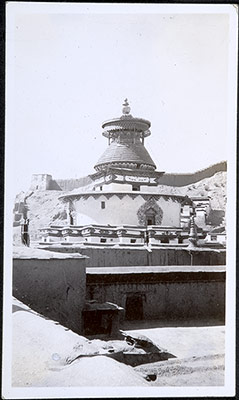
1999.23.1.10.6 (Album Print black & white)


1999.23.1.10.6 (Album Print black & white)

H. Staunton ?
Harry Staunton
1940 - 1941
Gyantse
1999.23.1.10.6
67 x 110 mm
Print gelatin silver
Donated 1999
Diana Hughes
H. Staunton
Diana Hughes
Notes on album mount - "Gyantse" is written in capital letters in pencil below the photograph.
Manual Catalogues - "The Pelkhor Chode" [Hugh Richardson in conversation with Roger Croston, detailed in H. Staunton undated Related Documents File, PRM Manuscript Collections] [KC 13/12/2005]
Other Information - Album: This image appears in Staunton's personal album on a page (1999.23.1.10) with five other images. [KC 9/12/2005]
Other Information - Setting: Gyurme Dorje writes in Tibet handbook, 1999 , Bath: Footprint Handbooks, p.260, "The great octagonal stupa of Gyantse - one of Tibet's outstanding artistic achievements, was built and decorated between 1427-39 by Prince Rabten Kunzang Phak in the style known as Tashi Gomang or Kumbum, which combines a terraced stupa exterior with multi-layered interior chapels. Rising 35 metres high, the stupas said to have 108 gates, nine storeys (including the base) and 75 chapels. ... Within the 75 chapels, the images form a progressive hierarchy of three dimensional mandalas, as outlined in the Sakyapa compilation known as the Drubtob Gyatsa, ensuring that the stupa encapsulates within it the entire spiritual path and gradation of the tantras." [KC 18/10/2006]
For Citation use:
The Tibet Album.
"Gyantse Kumbum"
05 Dec. 2006. The Pitt Rivers Museum.
<http://tibet.prm.ox.ac.uk/photo_1999.23.1.10.6.html>.
For more information about photographic usage or to order prints, please visit the The Pitt Rivers Museum.
© The Pitt Rivers Museum